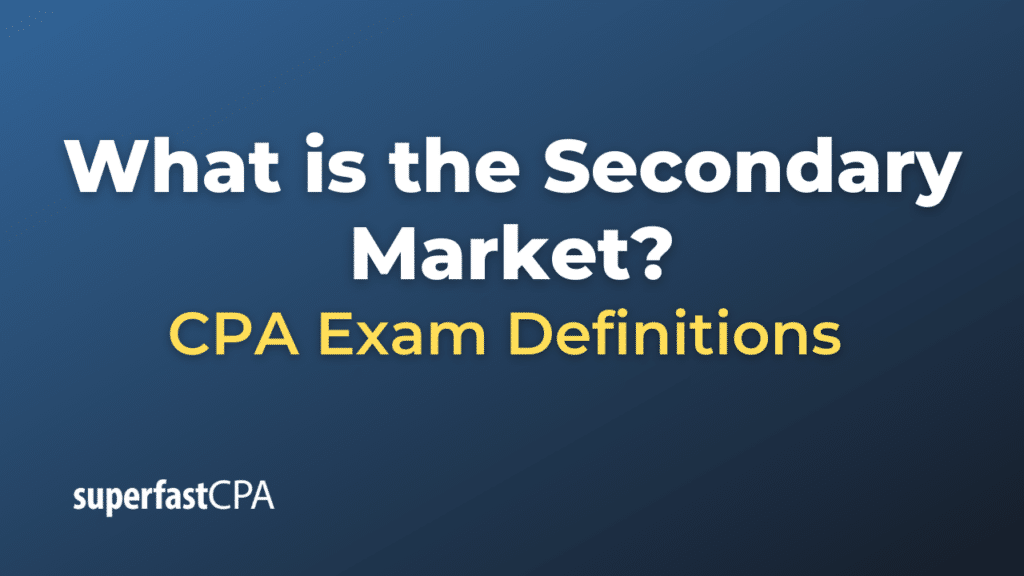Secondary Market
The secondary market, often simply referred to as “the market,” is where investors buy and sell securities they already own. It’s what most people typically think of as the “stock market,” though stocks are just one of the many types of financial instruments traded in secondary markets.
Here’s a more detailed overview:
- Definition: The secondary market is the financial market where previously issued financial instruments such as stock, bonds, options, and futures are bought and sold, as opposed to the primary market, where new securities are issued and sold to the public for the first time.
- Function: It provides liquidity for financial instruments, meaning it makes it easy for holders to sell and for others to buy. The ease with which securities can be traded is a key reason people invest in them. Without a secondary market, people would be less inclined to invest in primary markets because they would be unsure about their ability to easily cash out their investments.
- Types of Secondary Markets:
- Auction Market: Participants place bids and offers simultaneously, and a trade occurs when bids and offers match. The most common example is a stock exchange like the New York Stock Exchange (NYSE).
- Dealer Market (or Over-The-Counter, OTC): Dealers, or market makers, buy and sell for their own accounts. Securities are traded directly between two parties without a central exchange or broker. The NASDAQ is an example, where dealers provide bid-ask quotes and stand ready to buy or sell.
- Example: When you hear about someone buying shares of a company like Apple or Google on the stock market, they are purchasing those shares in the secondary market. These shares were previously issued (on the primary market) and are now being traded among investors.
- Importance: The secondary market is crucial for several reasons:
- Price Determination: It provides a platform where supply and demand meet, determining the price of a security.
- Liquidity : It offers investors the ability to exit an investment and convert it into cash.
- Risk Pricing: It aids in assessing the risk of an investment. The interactions of buyers and sellers help determine the perceived risk of any financial asset.
- Contrast with Primary Market: The primary market is where new securities are issued to the public, usually through a process called an Initial Public Offering (IPO). Once these securities are sold in the primary market, they can then be traded among investors in the secondary market.
In essence, the secondary market is essential for the efficient functioning of capital markets, allowing for price discovery, providing liquidity, and offering a platform for diverse financial instruments to be traded.
Example of the Secondary Market
Let’s delve into a practical example to illustrate the concept of the secondary market.
Example: Jenny’s Investment Journey with XYZ Corp.
Primary Market Interaction:
- XYZ Corp. Announces IPO: XYZ Corp., a tech startup, decides to go public to raise funds for expansion. They announce an Initial Public Offering (IPO) where they will issue new shares to the public.
- Jenny Buys During IPO: Jenny is interested in investing in tech startups. After conducting her research and consulting with her financial advisor, she decides to buy 100 shares of XYZ Corp. during its IPO at $10 per share, spending a total of $1,000.
At this point, Jenny’s interaction was with the primary market because she purchased newly issued shares directly from XYZ Corp.
Secondary Market Interaction:
- XYZ Corp.’s Performance: Over the next year, XYZ Corp. performs exceptionally well. It introduces innovative products, increases its revenue, and gains a larger market share.
- Share Price Appreciation: Due to the company’s strong performance and positive news in the tech sector, the share price of XYZ Corp. climbs to $20.
- Jenny Decides to Sell : Seeing the rise in share price and after evaluating her financial goals, Jenny decides to cash in on her investment. She sells all her 100 shares of XYZ Corp. on the stock exchange for $20 each, making a total of $2,000.
- Peter Buys XYZ Corp. Shares: Peter, another investor, has been watching XYZ Corp. and believes that the company has further growth potential. He decides to buy the 100 shares that Jenny is selling, paying $2,000.
In this scenario, Jenny and Peter’s transaction took place in the secondary market. Jenny sold shares she previously owned, and Peter bought those shares, hoping for future gains. XYZ Corp. did not directly benefit from this particular transaction since no new shares were issued, and the transaction occurred between two investors.
To recap, Jenny’s initial purchase of shares during the IPO took place in the primary market, whereas her sale of the shares to Peter occurred in the secondary market. This example highlights the distinction between the two markets and the typical investor journey within them.













